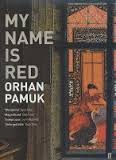296. My Name is Red by Orhan Pamuk
 This belongs to the books I read when my interest in read was waning. I did not get to review it. And I am not going to do so now. Again, I am going to state what I remember of this book so we can discuss it, if you have read it.
This belongs to the books I read when my interest in read was waning. I did not get to review it. And I am not going to do so now. Again, I am going to state what I remember of this book so we can discuss it, if you have read it.
One of the reasons I wanted to read Pamuk was that he is a Nobelist, having won it in 2006. Besides, he's Turkish and the Turkish have a rich history including the Ottoman Empire, making it a joy to read the level of sophistication of the time. This book covers a lot in just over 500 pages. I cannot seem to recollect and link the strands but this is what I remember:
- Each character narrates his part of the story in the first person in chapters dedicated to him or her. Thus there are multiple narrators in the story who are aware of each other. The narrators know each other and they know they are characters. The story begins with a murder with the would-be murder narrating his part of the story followed by a dog and a tree;
- The narrators are also aware of the reader and occasionally address the him or her. In fact, the reader is part of the narrative;
- The narrators sometimes refer to themselves in the third-person even when they are the ones narrating the story;
- The story is about the culture of the Turkish people during the famous Ottoman Empire and the nascent stages of Islam. It explains why artists or miniaturists of the time did not draw their objects - trees, humans - in a way as to make them be identified, as the Franks (Europeans) did.
A great European master miniaturist and another great master artist are walking through a Frank meadow discussing virtuosity and art. As they stroll, a forest comes into view before them. The more expert of the two says to the other: "Painting in the new style demands such talent that if you depicted one of the trees in this forest, a man who looked upon the painting could come here, and if he so desired, correctly select that tree from among the others".
I thank Allah that I, the humble tree before you, have not been drawn with such intent. And not because I fear that if I'd been thus depicted all the dogs in Istanbul would assume I was a real tree and piss on me: I don't want to be a tree, I want to be its meaning. (Chapter 10, Page 61)
- The book also discusses the unrest and military invasions and murders among Provinces and rulers;
- The making of books: printing, illustrations, and binding seemed to be one of the themes of this story. And love too.
- Pamuk made every significant thing he wanted to talk about, such as the role dogs played or how they are perceived; Death, to narrate its story. It is as if he does not want to be directly involve - like making the culture show itself to the reader instead.



Comments
Post a Comment
Help Improve the Blog with a Comment